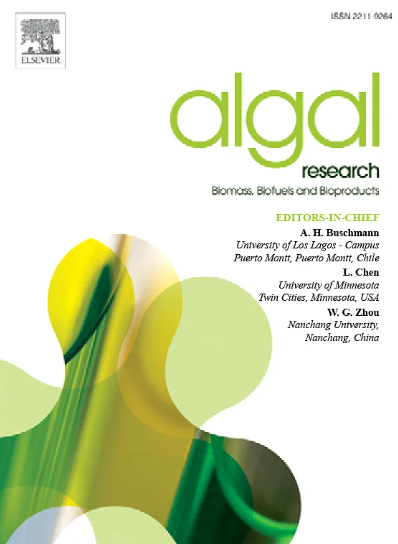Online multiparameter sensor for microalgae cultivation: prediction of nitrate, biomass and pigment concentrations
IF 4.6
2区 生物学
Q1 BIOTECHNOLOGY & APPLIED MICROBIOLOGY
Algal Research-Biomass Biofuels and Bioproducts
Pub Date : 2025-06-02
DOI:10.1016/j.algal.2025.104123
引用次数: 0
Abstract
Industrial microalgae production is widely recognized as a sustainable and promising method for generating nutraceuticals, biofertilizers, food ingredients, and feed. However, the lack of automated process control in current industrial facilities is a significant limitation, primarily due to the absence of sensors capable of measuring the growth medium's chemical composition and biomass. In this study, a novel method for simultaneously measuring several critical process parameters, including nitrate, various pigments, and biomass is presented. The approach is based on optical transmission and machine learning-based chemometrics and is reagent-free and non-invasive, making it ideal for development into an automated online device.
Measurements of optical spectra and chemical concentrations were conducted for two microalgae species, Arthrospira platensis and Tetradesmus obliquus, across different levels of biomass and nitrate. Through Partial Least Squares analysis of the data, biomass concentrations can be inferred in a range up to 8 g.L−1 (root mean square error (RMSE) of 0.55 g.L−1 and R2 0.75 for A. platensis, and RMSE of 0.52 g.L−1 and R2 0.88 for T. obliquus), using the same model for the different species (RMSE of 0.72 g.L−1 and R2 0.74). Nitrate concentrations can be estimated in a range between 0 and 800 mg.L−1 (RMSE of 41.70 mg.L−1, R2 of 0.82) in the presence of biomass and without the need to discriminate between the microalgae tested. For T. obliquus, total chlorophyl (from 2 to 18 mg.g−1 biomass, RMSE 1.24 mg.g−1 and R2 of 0.71) and carotenoids content (from 1 to 12 mg.g−1 biomass, RMSE 1.12 mg.g−1 and R2 of 0.59) can be estimated directly during the cultivation.
微藻培养的在线多参数传感器:硝酸盐、生物量和色素浓度的预测
工业微藻生产被广泛认为是一种可持续的、有前途的生产营养品、生物肥料、食品配料和饲料的方法。然而,目前工业设施中缺乏自动化过程控制是一个重大限制,主要是由于缺乏能够测量生长介质化学成分和生物量的传感器。在这项研究中,提出了一种同时测量几个关键工艺参数的新方法,包括硝酸盐、各种色素和生物量。该方法基于光传输和基于机器学习的化学计量学,无试剂和非侵入性,使其成为开发成自动化在线设备的理想选择。在不同生物量和硝酸盐水平下,对两种微藻——平节螺旋藻(Arthrospira platensis)和斜四角藻(Tetradesmus obliquus)进行了光谱和化学浓度的测量。通过对数据的偏最小二乘分析,生物量浓度可以在8 g的范围内推断出来。L−1(均方根误差(RMSE)为0.55 g。L−1,R2为0.75,RMSE为0.52 g。L−1,R2 0.88),对不同物种使用相同的模型(RMSE为0.72 g)。L−1,R2 0.74)。硝酸盐的浓度可在0至800毫克的范围内估计。L−1 (RMSE为41.70 mg)。L−1,R2为0.82),且不需要区分所测试的微藻。对于斜叶藻,总叶绿素(从2到18毫克)。g−1生物量,RMSE 1.24 mg。g−1,R2为0.71)和类胡萝卜素含量(1 ~ 12mg)。g−1生物量,RMSE 1.12 mg。g−1和R2为0.59)可在培养过程中直接估算。
本文章由计算机程序翻译,如有差异,请以英文原文为准。
求助全文
约1分钟内获得全文
求助全文
来源期刊

Algal Research-Biomass Biofuels and Bioproducts
BIOTECHNOLOGY & APPLIED MICROBIOLOGY-
CiteScore
9.40
自引率
7.80%
发文量
332
期刊介绍:
Algal Research is an international phycology journal covering all areas of emerging technologies in algae biology, biomass production, cultivation, harvesting, extraction, bioproducts, biorefinery, engineering, and econometrics. Algae is defined to include cyanobacteria, microalgae, and protists and symbionts of interest in biotechnology. The journal publishes original research and reviews for the following scope: algal biology, including but not exclusive to: phylogeny, biodiversity, molecular traits, metabolic regulation, and genetic engineering, algal cultivation, e.g. phototrophic systems, heterotrophic systems, and mixotrophic systems, algal harvesting and extraction systems, biotechnology to convert algal biomass and components into biofuels and bioproducts, e.g., nutraceuticals, pharmaceuticals, animal feed, plastics, etc. algal products and their economic assessment
 求助内容:
求助内容: 应助结果提醒方式:
应助结果提醒方式:


